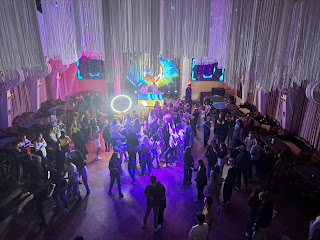2. Odesa Student Fest
Now I have been to Odesa for a week or so, and my local German friends bring me along to one of the few big party series still going strong despite the curfew, mobilization of many young men, and resistance of many (but not all) residents of the city to partying at the time of war. It is the Odesa Student Fest - if not the biggest, then surely the oldest party series in Odesa. It has been organized by the same group of people for nine years. OSF is an event that used to be held in different party venues around the city but has now remained faithful to the stylish nightclub Ministerium on Hoholia Street, a stone's throw from Derybasivska. According to the organizers, before the war, OSF regularly attracted 1500 people; nowadays, they are happy to see 300-400 people turn up for the party, which starts at 4 pm and ends around 10 pm.
But those who do turn up seem to get everything out of the party - at the latest two hours after the event starts, the neo-baroque hall of the Ministerium is packed with young people, some of whom can't be older than 14-15, giggling self-deprecatingly. The bartenders, who are at least half as old, calmly pour beer, wine, gin and tonic, or other mixed drinks for anyone who shows their hryvnias, and, unless there's a fight (which there is, mostly on the street in front of the club), the middle-aged security guards don't raise an eyebrow.
Soon I can see young men jumping around aimlessly, girls rushing to the toilet to vomit, and couples kissing and brazenly groping each other. At the same time, some of the party-goers are standing, sitting, kneeling, or hanging around in the smoking room, which has a carpeted floor and is filled with blue-gray clouds of smoke. At the same time, e-cigarettes are allowed in the party room, but one has to go to the smoking room to enjoy the 'analogue' tobacco. The invitingly soft carpet is also used as a way of recovering from the fatigue of the fast-paced drinks.
The party takes place once a month, costs a couple of hundred hryvnias (about €4) to enter, and indeed, no one seems to be denied entry. At the door, the handbags and waistbands of young men and women alike are searched, and a security guard also scans visitors' bodies with thoroughness not seen at airports, but no documents are checked, and no one is judged too young by their face. Surely, in hard times, every visitor is welcome. There is also a noticeable predominance of girls at the party, which is probably why boys who are obviously only in secondary school are also generously allowed in. However, the girls' Botoxed lips and thick makeup make it difficult to determine their age...
The parties usually have a theme, but what it is, apart from the slogan written on the party poster - Love Party, Girls Party, Budmo (cheers in Ukrainian) Party, remains incomprehensible. The tune is pretty much the same every time, the repertoire consists of a mix of local and western music, Ukrainian flags are flying on the screens behind the DJ, and some of the songs are emphatically patriotic. Some of the more overtly propaganda songs are punctuated by drunken shouting from the youngsters on the dancefloor, and there are also jolly statements to be heard about Putin being sent to various places.
The party ends around 22:00 - with the singing of the national anthem -, and then there are fights between groups of young people on the street in front of the building, as they gradually stagger home. Thus, at the end of the Girls Party on 8 March - International Women's Day, which is very important in Ukraine -, it was possible to see young women in the street punching young men who had overdone their drinking. As my Ukrainian friends then explained, this kind of behavior - including drinking that had already begun at work or at the lunch table during the day - is a woman's privilege on International Women's Day.
It was also a kind of privilege to witness it.





Comments
Post a Comment